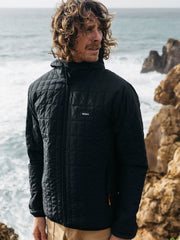Wetsuits From Wetsuits.
20.12.18
4 min read
For many the irony of the situation is not lost. Getting in the sea is one of the most cleansing, therapeutic activities you can do. Yet we often have to wear a wetsuit, traditionally made from some of the most un-environmentally friendly materials out there, that take lifetimes to break down.
As we continued to push our wetsuit design further, the next step of our journey saw us create our first eco wetsuit, made from Yulex, a bio-rubber harvested from FCS certified sources that provides the same performance benefits of traditional neoprene but with significantly reduced environmental impact.
But we could do better
In November 2017 we hired the world’s first ever full-time wetsuit recycler. After partnering with the University of Exeter’s centre for material re-engineering, and with Innovate UK’s support to create the role, Jenny Banks was chosen as the inquisitive mind who could challenge the status quo and drive us towards our goal.
“There have been great advances in eco wetsuits and the search for alternatives to petroleum-based neoprene, but the real elephant in the room for the water-sports industry is what to do with a wetsuit at the end of its functional life.”
Tom Kay, Finisterre Founder
Why are wetsuits so difficult to recycle?
For the first 6 months of the wetsuits from wetsuits programme we were on a learning mission. With extensive lab testing we were able to identify which wetsuit panels would need repair or could be repurposed. The testing also allowed us to challenge traditional wetsuit manufacture and question whether the material complexity of current wetsuits is even necessary.
“Wetsuits have pretty much been made in the same way since the 1950s. In order for us to re-imagine the wetsuit and think freely, it was really important we understood the wetsuit at every level.”
Jenny Banks, Finisterre Wetsuit Recycler
This material complexity is what makes recycling a wetsuit such a challenge. A single suit can use up to 15 different types of neoprene and/or rubber composites, and features like fabric linings make wetsuit recycling nearly impossible. They’re used to add strength and durability, but we have found alternatives that don’t compromise recyclability. Seams can also be troublesome as they similarly require the use of fabrics, however we’ve been innovating in this area to design a wetsuit seam that uses fewer materials and can be recycled.
Surprisingly, one thing our lab testing on our old tester suits highlighted was that wetsuits degrade far more slowly than one might think. Even after a couple of years, aesthetically the suit might not look as good, but in terms of performance, there is actually very little degradation.
So, how do you recycle a wetsuit?
The difficulty is that Neoprene/Yulex are inherently difficult to recycle because they are thermoset elastomer materials. This means that unlike a plastic bottle, they can’t simply be melted down and re-processed to make new material. Breaking down wetsuits in the form that they’re currently designed means the quality of the material produced would be low, however we are working with partners who are pioneering a new approach that may allow for the recycling of entire suits.
Our own wetsuit re-design phase focused on simplifying the materials used in our suits, so that the performance quality of our materials remains intact during the recycling process, with the aim of reintroducing them to the manufacturing process without compromising performance.
Testing the world’s first recyclable wetsuit (prototype)
After long days spent in the lab and cold mornings trialling different designs in Atlantic waters, we’ve done it. We’ve built the world’s first recyclable wetsuit prototype.
We're currently putting it through its paces and continuing our rigorous testing to make sure the performance is up to scratch. We know that no-one will buy a wetsuit simply because it’s more sustainable, it also has to be a great suit – just as warm, just as flexible. So the testing must continue.
Next Steps
Designing for recyclability is a much needed, forward thinking solution to the problem. However, a bigger global issue is the literal tons (380 every year, to be precise) of old wetsuits out there destined for landfill. With this in mind Finisterre is teaming up with pioneers in the recycling industry to further explore the chemical recycling of suits in their current form.
In the future we are aiming to launch a wetsuit ‘buy back scheme’ where old suits can be traded in to be recycled, for discounts on new suits or store vouchers.


















































































